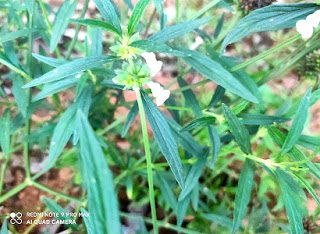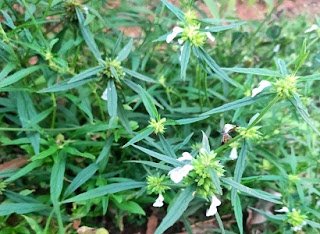Thumbe gida, thumbe hoovu uses
A small plant called thumbe gida can be seen in the fields of ragi, rice, where it is grown abundantly, bearing white flowers, this plant, which is a weed in the fields that grows on its own, but thumbe gida is sacred as well as a medicinal plant like Tulsi plant.
Thumbe gida grows 1-1.5 feet in height that grows easily in wider weather conditions. Thumbe plant needs less water to grow. It bears a small white flower with sweet nectar which attracts insects. It can also be seen at the banks of rivers, lakeside and in forest areas. You may have seen these plant roadsides, in parks also.
Although the plant grows on its own in the fields, it can be grown from the seeds in pots. It takes three months to grow well with flowers. Thumbe plant can be seen in South Asian countries.
Thumbe plant has many varieties depending on the colour of the flowers. Among them, the white flower-bearing plant is considered sacred and is used in home remedies.
Thumbe gida in English is Ceylon slitwort and its scientific name is Leucas Aspera. It is called drona, dronapushpa, kumbhayoni, chithra kshupa in Sanskrit, Guma madhupathi in Hindi, Peddatumani, thummi chittu in Telugu, thumba poovu in Malayalam, Thumbe gida in Kannada.
Thumbe hoovu is considered a sacred flower in India and it is offered to Lord Shiva during Shivaratri festival.
Thumbe gida as a whole plant has a lot of medicinal values and its root, stem, leaves flower is used in home remedies as well as in ayurvedic medicines. The leaves of this plant are pungent in taste. This herbal plant is used as medicine for ages.
Thumbe plant as a whole with leaves, stem, root and flowers are used in home remedies which cures recurring fever, skin infection, inflammation, cold and cough, eye infection and jaundice. Thumbe leaves are also used as a leafy vegetable.
Thumbe soppu in home remedies
For recurring fever
Thumbe stem, leaves and flowers are cleaned and dried in shadow. Then it is powdered. Prepare kashaya from this powder. Boil a cup of water adding one spoon of this powder and black pepper powder, till the amount of water reduces to half. Then strain this and take this preparation 2-3 times a day relieves from fever.
For menstrual problem
Thumbe leaves paste is taken with lime juice and sesame oil cures heavy bleeding during menstruation.
For Scorpion bite
Thumbe leaves paste is applied to the scorpion bite wound to avoid the poison spreading. Thumbe leaves juice is also taken with milk at the same time helps to control the spreading of poison in the body.
For digestion problems
Thumbe leaves and root kashaya is taken with saindhava lavana or rock salt improves digestion. It also purifies blood and improves immunity against allergy.
For joint pain
Thumbe leaves juice is mixed with jaggery and slaked lime called sunna. This mixture is applied to the joints relieves the joint pain. It also relieves inflammation.
For skin problems
Thumbe leaves juice is applied to skin diseases decreases the condition. Thumbe plant as a whole is added to boiling water and kept for 10 minutes. This water is mixed with bathing water, relieves from skin itching and other skin conditions.
The stem of the plant when freshly cut a milky substance oozes out can also be applied to the skin to cre skin infection.
Thumbe leaves with neem leaves kashaya is also used during bathing helps to cure skin allergies. It can also be used as a face wash which gives a nice glow.
For tonsil problem
Thumbe leaves paste is applied on the inflamed part of the neck and leaves juice is taken orally with honey helps to overcome the condition.
For jaundice
Thumbe leaves juice is taken with honey two times a day before food with a controlled diet. Apply 2-3 drops of thumbe hoovu juice to the eyes. This remedy helps to get relief from jaundice. Thumbe leaves are boiled with water and taken with food to improve the health of the liver.
As antiseptic
Thumbe plant kashaya is prepared and used to clean wounds. It is one of the natural antiseptics used for ages. It also helps in the fast healing of wounds.
Thumbe flower or thumbe hoovu benefits
For cold and cough
Thumbe flower juice is mixed with honey and is taken 2-3 times before food cures cold and cough. It also helps to get relief from phlegm. This juice is used as nose drops for sinusitis.
For stomach worms
Thumbe flower juice with honey is the home remedy used for stomach worms in children.
For eye infection
Thumbe flower juice is mixed with milk and 2-3 drops of this preparation are applied to the eyes relieves from itching and burning sensation of eyes.
For headache
Thumbe flower is mixed with sesame oil and the mixture is applied on hair half an hour before taking bath. It relieves headaches and migraine is also cured. Thumbe plant with flower is added to water and steam is inhaled relieves from headache.
Thumbe plant as an insect repellant
If you grow thumbe plants around your house, it acts as an insect repellant. It avoids insects like mosquitoes and thus helps to avoid many diseases. If the dried leaves of the thumbe plant are burned during the evening, the fumes keep the insects at bay.
Thumbe flower in religious importance
The Thumbe plant is as sacred as the Tulsi plant in India. Thumbe flower is always been a part of rituals and the thumbe flower is considered as sacred flower Lord Shiva likes.
Thumbe flower is also called Rudrapushpa as it is a favourite to Rudra. This flower is offered to Lord Shiva during the Shivarathri festival.
Thumbe flower has also mythological importance. It is said that during Samudra Mathana by sura and asuras, Shiva had to drink the poison that appeared. The poison effect on Lord Shiva was relieved with the help of the thumbe flower.
You may also read







Please do not enter any spam link in the comment box ConversionConversion EmoticonEmoticon